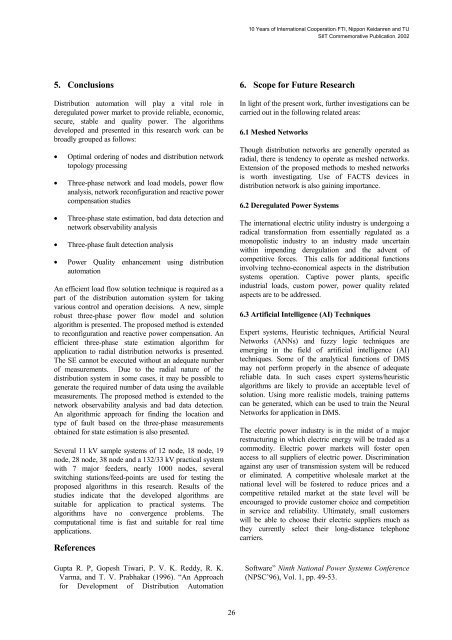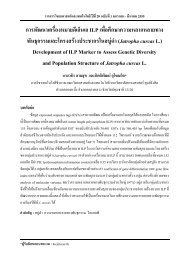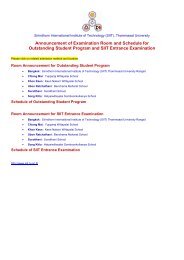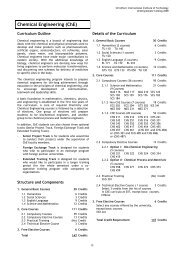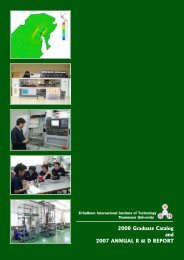<strong>10</strong> <strong>Years</strong> <strong>of</strong> <strong>International</strong> Cooperation: FTI, Nippon Keidanren and TU<strong>SIIT</strong> <strong>Commemorative</strong> <strong>Publication</strong>, 20025. ConclusionsDistribution automation will play a vital role inderegulated power market to provide reliable, economic,secure, stable and quality power. The algorithmsdeveloped and presented in this research work can bebroadly grouped as follows:• Optimal ordering <strong>of</strong> nodes and distribution networktopology processing• Three-phase network and load models, power flowanalysis, network reconfiguration and reactive powercompensation studies• Three-phase state estimation, bad data detection andnetwork observability analysis• Three-phase fault detection analysis• Power Quality enhancement using distributionautomationAn efficient load flow solution technique is required as apart <strong>of</strong> the distribution automation system for takingvarious control and operation decisions. A new, simplerobust three-phase power flow model and solutionalgorithm is presented. The proposed method is extendedto reconfiguration and reactive power compensation. Anefficient three-phase state estimation algorithm forapplication to radial distribution networks is presented.The SE cannot be executed without an adequate number<strong>of</strong> measurements. Due to the radial nature <strong>of</strong> thedistribution system in some cases, it may be possible togenerate the required number <strong>of</strong> data using the availablemeasurements. The proposed method is extended to thenetwork observability analysis and bad data detection.An algorithmic approach for finding the location andtype <strong>of</strong> fault based on the three-phase measurementsobtained for state estimation is also presented.Several 11 kV sample systems <strong>of</strong> 12 node, 18 node, 19node, 28 node, 38 node and a 132/33 kV practical systemwith 7 major feeders, nearly <strong>10</strong>00 nodes, severalswitching stations/feed-points are used for testing theproposed algorithms in this research. Results <strong>of</strong> thestudies indicate that the developed algorithms aresuitable for application to practical systems. Thealgorithms have no convergence problems. Thecomputational time is fast and suitable for real timeapplications.ReferencesGupta R. P, Gopesh Tiwari, P. V. K. Reddy, R. K.Varma, and T. V. Prabhakar (1996). “An Approachfor Development <strong>of</strong> Distribution Automation6. Scope for Future ResearchIn light <strong>of</strong> the present work, further investigations can becarried out in the following related areas:6.1 Meshed NetworksThough distribution networks are generally operated asradial, there is tendency to operate as meshed networks.Extension <strong>of</strong> the proposed methods to meshed networksis worth investigating. Use <strong>of</strong> FACTS devices indistribution network is also gaining importance.6.2 Deregulated Power SystemsThe international electric utility industry is undergoing aradical transformation from essentially regulated as amonopolistic industry to an industry made uncertainwithin impending deregulation and the advent <strong>of</strong>competitive forces. This calls for additional functionsinvolving techno-economical aspects in the distributionsystems operation. Captive power plants, specificindustrial loads, custom power, power quality relatedaspects are to be addressed.6.3 Artificial Intelligence (AI) TechniquesExpert systems, Heuristic techniques, Artificial NeuralNetworks (ANNs) and fuzzy logic techniques areemerging in the field <strong>of</strong> artificial intelligence (AI)techniques. Some <strong>of</strong> the analytical functions <strong>of</strong> DMSmay not perform properly in the absence <strong>of</strong> adequatereliable data. In such cases expert systems/heuristicalgorithms are likely to provide an acceptable level <strong>of</strong>solution. Using more realistic models, training patternscan be generated, which can be used to train the NeuralNetworks for application in DMS.The electric power industry is in the midst <strong>of</strong> a majorrestructuring in which electric energy will be traded as acommodity. Electric power markets will foster openaccess to all suppliers <strong>of</strong> electric power. Discriminationagainst any user <strong>of</strong> transmission system will be reducedor eliminated. A competitive wholesale market at thenational level will be fostered to reduce prices and acompetitive retailed market at the state level will beencouraged to provide customer choice and competitionin service and reliability. Ultimately, small customerswill be able to choose their electric suppliers much asthey currently select their long-distance telephonecarriers.S<strong>of</strong>tware” Ninth National Power Systems Conference(NPSC’96), Vol. 1, pp. 49-53.26
<strong>10</strong> <strong>Years</strong> <strong>of</strong> <strong>International</strong> Cooperation: FTI, Nippon Keidanren and TU<strong>SIIT</strong> <strong>Commemorative</strong> <strong>Publication</strong>, 2002IEEE Power Engineering Review on Power Quality,September 2001, Vol. 21, No. 9, pp. 5-11.Jerome Jovitha (2001a). “Distribution NetworkReconfiguration and Reactive Power Compensation”,Proceedings <strong>of</strong> the 2001 Large Engineering SystemsConference on Power Engineering (LESCOPE 01),11-13 July 2001, Halifax, Nova Scotia, Canada, pp.117-183.Jerome Jovitha (2001b). “Network Observability andBad Data Processing Algorithm for DistributionNetworks”, Proceedings <strong>of</strong> the IEEE PowerEngineering Society 2001 Summer Meeting, 15-19July 2001, Vancouver, BC, Canada, pp. 1692-1697.Jerome Jovitha (2001c). “Distribution AutomationImpact on Power Quality”, Proceedings <strong>of</strong> the<strong>International</strong> Conference on Power Quality SynergyAsia 2001, 14-16 May 2001, Bangkok, Thailand.Jerome Jovitha (2002). “Power Quality EnhancementTrends”, Proceedings <strong>of</strong> the <strong>International</strong>Conference on Power Quality Synergy Asia 2002, 20-22 May 2002, Bangkok, Thailand.Markushevich S. Nokhum, Ivan C. Herejk and Ron E.Nielsen (1994). “Functional Requirement and Cost-Benefit Study for Distribution Automation at B. C.Hydro”, IEEE Trans. on Power Systems, Vol. 9, No.2, pp. 772-781.Narendranath Udupa, D. Thukaram, K. Parthasarathyand G. S. Raju (1994). “Computer Aided Algorithmsfor Distribution System Planning and Improvements”,Proceedings <strong>of</strong> VIII National Power SystemsConference (NPSC 94).Flow Method for Weakly Meshed Distribution andTransmission Networks”, IEEE Trans. on PowerSystems, Vol. 3, No. 2, pp. 753-762.Thukaram D., Jerome Jovitha and C. Surapong(2000a). “A Robust Three-Phase State EstimationAlgorithm for Distribution Networks”, ElectricalPower Systems Research, September 2000, Vol. 55,No. 3, pp. 191-200.Thukaram D., Jerome Jovitha and C. Surapong(2000b). “A Three Phase Fault Detection Algorithmfor Radial Distribution Networks”, Proceedings <strong>of</strong>Eleventh National Power Systems Conference(NPSC), Indian Institute <strong>of</strong> Science (I.I.Sc.), 20-22December 2000, Bangalore, India, pp. 376-382.Thukaram D., Jerome Jovitha, H. M. Wijekoon Banda,C. Surapong, S. C. Srivastava (1999a). “A RobustPower Flow Algorithm for Radial DistributionSystems”, Proceedings <strong>of</strong> the <strong>International</strong> PowerEngineering Conference (IPEC'90), 24-26 May 1999,Singapore, pp. 458-463.Thukaram D., Jerome Jovitha, H. M. Wijekoon Banda(1999b). “A Robust Three-Phase Power FlowAlgorithm for Radial Distribution Systems”,Electrical Power Systems Research, June 1999, Vol.50, No. 3, pp. 227-236.Thukaram D., Jerome Jovitha, H. M. Wijekoon Banda,S. C. Srivastava (1998). “A Robust State EstimationAlgorithm for Radial Networks”, Proceedings <strong>of</strong> the14th National Convention <strong>of</strong> Electrical Engineers onModern Trends in the Transmission Systems, IndianInstitute <strong>of</strong> Technology (I.I.T.), 20-22 December1998, Kanpur, India.Shirmohammadi Dariush, H. W. Hong, A. Semlyen andG. X. Luo (1988). “A Compensation-based Power27
- Page 2 and 3:
!" Years of International Cooperati
- Page 5 and 6:
1993: Her Royal HighnessPrincess Ma
- Page 7 and 8:
!"#$%&'(#)*#+,-%',&-.),&/#0))1%'&-.
- Page 9 and 10:
!"#$%&'(#)*#+,-%',&-.),&/#0))1%'&-.
- Page 11 and 12: !"#$%&'(#)*#+,-%',&-.),&/#0))1%'&-.
- Page 13 and 14: !"#$%&'(#)*#+,-%',&-.),&/#0))1%'&-.
- Page 15 and 16: !!!"#$%&'(#)*#+,-%',&-.),&/#0))1%'&
- Page 17 and 18: !!!"#$%&'(#)*#+,-%',&-.),&/#0))1%'&
- Page 19 and 20: !!"#$%&'(#)*#+,-%',&-.),&/#0))1%'&-
- Page 21 and 22: !!"#$%&'(#)*#+,-%',&-.),&/#0))1%'&-
- Page 23 and 24: "#!$%&'(!)*!+,-%',&-.),&/!0))1%'&-.
- Page 25 and 26: !!"#$%&'(#)*#+,-%',&-.),&/#0))1%'&-
- Page 27 and 28: !"#$%&'(#)*#+,-%',&-.),&/#0))1%'&-.
- Page 29 and 30: !"#$%&'(#)*#+,-%',&-.),&/#0))1%'&-.
- Page 31 and 32: !"#$%&'(#)*#+,-%',&-.),&/#0))1%'&-.
- Page 33 and 34: !"#$%&'(#)*#+,-%',&-.),&/#0))1%'&-.
- Page 35 and 36: !"#$%&'(#)*#+,-%',&-.),&/#0))1%'&-.
- Page 37 and 38: 10 Years of International Cooperati
- Page 39 and 40: 10 Years of International Cooperati
- Page 41 and 42: 10 Years of International Cooperati
- Page 43 and 44: 10 Years of International Cooperati
- Page 45 and 46: 10 Years of International Cooperati
- Page 47 and 48: 10 Years of International Cooperati
- Page 49 and 50: 10 Years of International Cooperati
- Page 51 and 52: 10 Years of International Cooperati
- Page 53 and 54: 10 Years of International Cooperati
- Page 55 and 56: 10 Years of International Cooperati
- Page 57 and 58: 10 Years of International Cooperati
- Page 59 and 60: 10 Years of International Cooperati
- Page 61: 10 Years of International Cooperati
- Page 65 and 66: !!"#$%&'(#)*#+,-%',&-.),&/#0))1%'&-
- Page 67 and 68: !!"#$%&'(#)*#+,-%',&-.),&/#0))1%'&-
- Page 69 and 70: #!"#$%&'(#)*#+,-%',&-.),&/#0))1%'&-
- Page 71 and 72: #!"#$%&'(#)*#+,-%',&-.),&/#0))1%'&-
- Page 73 and 74: #!"#$%&'(#)*#+,-%',&-.),&/#0))1%'&-
- Page 75 and 76: 10 Years of International Cooperati
- Page 77 and 78: 10 Years of International Cooperati
- Page 79 and 80: 10 Years of International Cooperati
- Page 81 and 82: 10 Years of International Cooperati
- Page 83 and 84: 10 Years of International Cooperati
- Page 85 and 86: 10 Years of International Cooperati
- Page 87 and 88: !!"#$%&'(#)*#+,-%',&-.),&/#0))1%'&-
- Page 89 and 90: !!!"#$%&'(#)*#+,-%',&-.),&/#0))1%'&
- Page 91 and 92: !"#!$%&'(!)*!+,-%',&-.),&/!0))1%'&-
- Page 93 and 94: !"#!$%&'(!)*!+,-%',&-.),&/!0))1%'&-
- Page 95 and 96: !"#!$%&'(!)*!+,-%',&-.),&/!0))1%'&-
- Page 97 and 98: !"#$%&'(#)*#+,-%',&-.),&/#0))1%'&-.
- Page 99 and 100: !"#$%&'(#)*#+,-%',&-.),&/#0))1%'&-.
- Page 101 and 102: !!"#$%&'(#)*#+,-%',&-.),&/#0))1%'&-
- Page 103 and 104: !!"#$%&'(#)*#+,-%',&-.),&/#0))1%'&-
- Page 105 and 106: !!"#$%&'(#)*#+,-%',&-.),&/#0))1%'&-
- Page 107 and 108: 10 Years of International Cooperati
- Page 109 and 110: !!"#$%&'(#)*#+,-%',&-.),&/#0))1%'&-
- Page 111 and 112: !!"#$%&'(#)*#+,-%',&-.),&/#0))1%'&-
- Page 114 and 115:
10 Years of International Cooperati
- Page 116 and 117:
!"#$%&'(#)*#+,-%',&-.),&/#0))1%'&-.
- Page 118 and 119:
!"#$%&'(#)*#+,-%',&-.),&/#0))1%'&-.
- Page 120 and 121:
!"#$%&'(#)*#+,-%',&-.),&/#0))1%'&-.
- Page 122 and 123:
!"#$%&'(#)*#+,-%',&-.),&/#0))1%'&-.
- Page 124 and 125:
!"#$%&'(#)*#+,-%',&-.),&/#0))1%'&-.
- Page 126 and 127:
!"#$%&'(#)*#+,-%',&-.),&/#0))1%'&-.
- Page 128 and 129:
!"#$%&'(#)*#+,-%',&-.),&/#0))1%'&-.
- Page 130 and 131:
!"#$%&'(#)*#+,-%',&-.),&/#0))1%'&-.
- Page 132 and 133:
!"#$%&'(#)*#+,-%',&-.),&/#0))1%'&-.
- Page 134 and 135:
!"#$%&'(#)*#+,-%',&-.),&/#0))1%'&-.
- Page 136 and 137:
!!"#$%&'(#)*#+,-%',&-.),&/#0))1%'&-
- Page 138 and 139:
!!"#$%&'(#)*#+,-%',&-.),&/#0))1%'&-
- Page 140 and 141:
!!"#$%&'(#)*#+,-%',&-.),&/#0))1%'&-
- Page 142 and 143:
!!"#$%&'(#)*#+,-%',&-.),&/#0))1%'&-
- Page 144 and 145:
!!"#$%&'(#)*#+,-%',&-.),&/#0))1%'&-
- Page 146 and 147:
!!"#$%&'(#)*#+,-%',&-.),&/#0))1%'&-
- Page 148 and 149:
!!"#$%&'(#)*#+,-%',&-.),&/#0))1%'&-
- Page 150 and 151:
!!"#$%&'(#)*#+,-%',&-.),&/#0))1%'&-
- Page 152 and 153:
!"#!$%&'(!)*!+,-%',&-.),&/!0))1%'&-
- Page 154 and 155:
"#!$%&'(!)*!+,-%',&-.),&/!0))1%'&-.
- Page 156 and 157:
!!"#$%&'(#)*#+,-%',&-.),&/#0))1%'&-
- Page 158 and 159:
!"#$%&'(#)*#+,-%',&-.),&/#0))1%'&-.
- Page 160 and 161:
#!"#$%&'(#)*#+,-%',&-.),&/#0))1%'&-
- Page 162 and 163:
Access to SIIT at Bangkadi!!!",':!D


